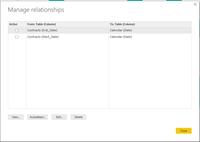FabCon is coming to Atlanta
Join us at FabCon Atlanta from March 16 - 20, 2026, for the ultimate Fabric, Power BI, AI and SQL community-led event. Save $200 with code FABCOMM.
Register now!- Power BI forums
- Get Help with Power BI
- Desktop
- Service
- Report Server
- Power Query
- Mobile Apps
- Developer
- DAX Commands and Tips
- Custom Visuals Development Discussion
- Health and Life Sciences
- Power BI Spanish forums
- Translated Spanish Desktop
- Training and Consulting
- Instructor Led Training
- Dashboard in a Day for Women, by Women
- Galleries
- Data Stories Gallery
- Themes Gallery
- Contests Gallery
- Quick Measures Gallery
- Notebook Gallery
- Translytical Task Flow Gallery
- TMDL Gallery
- R Script Showcase
- Webinars and Video Gallery
- Ideas
- Custom Visuals Ideas (read-only)
- Issues
- Issues
- Events
- Upcoming Events
Calling all Data Engineers! Fabric Data Engineer (Exam DP-700) live sessions are back! Starting October 16th. Sign up.
- Power BI forums
- Forums
- Get Help with Power BI
- Desktop
- Count the number of Start and end dates in a given...
- Subscribe to RSS Feed
- Mark Topic as New
- Mark Topic as Read
- Float this Topic for Current User
- Bookmark
- Subscribe
- Printer Friendly Page
- Mark as New
- Bookmark
- Subscribe
- Mute
- Subscribe to RSS Feed
- Permalink
- Report Inappropriate Content
Count the number of Start and end dates in a given month, quarter, etc.
Hi, I have a table of contracts with start and end dates and need to plot on a graph the number of contracts that end or start in a given month. Any ideas?
Solved! Go to Solution.
- Mark as New
- Bookmark
- Subscribe
- Mute
- Subscribe to RSS Feed
- Permalink
- Report Inappropriate Content
Hi @Anonymous,
Taking into account that you have two date columns first of all I would create a calendar table (tutorial calendar table).
1 - Create a two non-active relationships between the Calendar table and your Start and End Date:
2 - Add the following measures:
Start_Date_Count =
CALCULATE (
COUNT ( Contracts[Contract] ),
USERELATIONSHIP ( 'Calendar'[Date], Contracts[Start_Date] )
)
End_date_Count =
CALCULATE (
COUNT ( Contracts[Contract] ),
USERELATIONSHIP ( 'Calendar'[Date], Contracts[End_Date] )
)If need only one measure create the following measure:
Total_Date_Count =
CALCULATE (
COUNT ( Contracts[Contract] ),
USERELATIONSHIP ( 'Calendar'[Date], Contracts[Start_Date] )
)
+ CALCULATE (
COUNT ( Contracts[Contract] ),
USERELATIONSHIP ( 'Calendar'[Date], Contracts[End_Date] )
)
3 - Create your visuals with the desired measure.
See below a sample with my table, the visuals with start and end month calculation and another with the measures I created to see the result is the same, with the Calendar table you can create slicers that will allow you to show only the information you want.
Regards,
MFelix
Regards
Miguel Félix
Did I answer your question? Mark my post as a solution!
Proud to be a Super User!
Check out my blog: Power BI em Português- Mark as New
- Bookmark
- Subscribe
- Mute
- Subscribe to RSS Feed
- Permalink
- Report Inappropriate Content
Hi @Anonymous,
Taking into account that you have two date columns first of all I would create a calendar table (tutorial calendar table).
1 - Create a two non-active relationships between the Calendar table and your Start and End Date:
2 - Add the following measures:
Start_Date_Count =
CALCULATE (
COUNT ( Contracts[Contract] ),
USERELATIONSHIP ( 'Calendar'[Date], Contracts[Start_Date] )
)
End_date_Count =
CALCULATE (
COUNT ( Contracts[Contract] ),
USERELATIONSHIP ( 'Calendar'[Date], Contracts[End_Date] )
)If need only one measure create the following measure:
Total_Date_Count =
CALCULATE (
COUNT ( Contracts[Contract] ),
USERELATIONSHIP ( 'Calendar'[Date], Contracts[Start_Date] )
)
+ CALCULATE (
COUNT ( Contracts[Contract] ),
USERELATIONSHIP ( 'Calendar'[Date], Contracts[End_Date] )
)
3 - Create your visuals with the desired measure.
See below a sample with my table, the visuals with start and end month calculation and another with the measures I created to see the result is the same, with the Calendar table you can create slicers that will allow you to show only the information you want.
Regards,
MFelix
Regards
Miguel Félix
Did I answer your question? Mark my post as a solution!
Proud to be a Super User!
Check out my blog: Power BI em Português- Mark as New
- Bookmark
- Subscribe
- Mute
- Subscribe to RSS Feed
- Permalink
- Report Inappropriate Content
Thanks so much. Works a charm. I then tried to use a waterfall charter with a measure of Runners difference = [Starters]-[Leavers]. This works but doesn't filter by User/Sales person. Any ideas?
- Mark as New
- Bookmark
- Subscribe
- Mute
- Subscribe to RSS Feed
- Permalink
- Report Inappropriate Content
Hi @Anonymous,
How does the User/Sales person connects to this measures? Is it on a separeted table or on the same table?
Regards,
MFelix
Regards
Miguel Félix
Did I answer your question? Mark my post as a solution!
Proud to be a Super User!
Check out my blog: Power BI em PortuguêsHelpful resources

FabCon Global Hackathon
Join the Fabric FabCon Global Hackathon—running virtually through Nov 3. Open to all skill levels. $10,000 in prizes!

Power BI Monthly Update - September 2025
Check out the September 2025 Power BI update to learn about new features.



